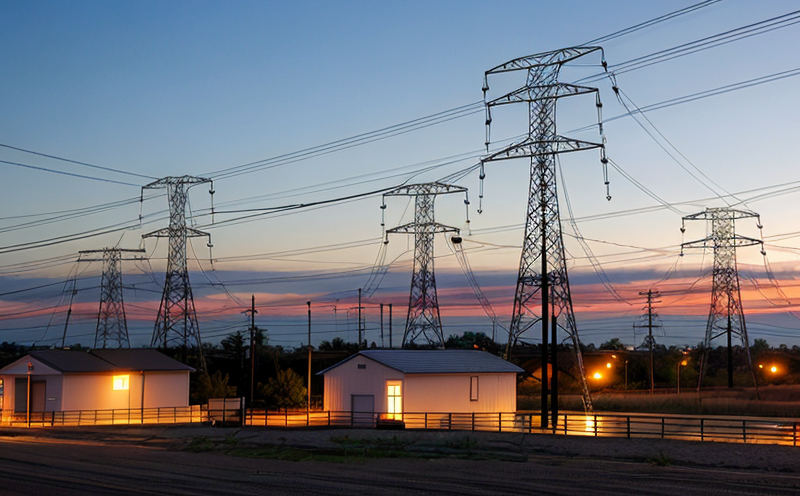IEEE 519 Harmonic Distortion Load Testing in Electrical Grids
The IEEE Standard 519-2014 sets forth guidelines on voltage total harmonic distortion (VTHD) and current total harmonic distortion (IHTD) to ensure that electrical networks operate efficiently, reliably, and without excessive harmonic content. Compliance with this standard is essential for power utility companies, industrial facilities, and other entities connected to the grid to maintain system integrity.
Harmonic distortions arise from nonlinear loads such as variable frequency drives (VFDs), uninterruptible power supplies (UPS), and switching devices used in modern electrical systems. These distortions can lead to increased energy losses, equipment damage, and reduced service life of components within the grid. By conducting IEEE 519 Harmonic Distortion Load Testing, facilities ensure they are meeting regulatory requirements and optimizing their operations.
The testing process typically involves measuring voltage and current waveforms at various points in the electrical distribution system to determine the harmonic content. This data is then analyzed against the criteria outlined in IEEE Standard 519-2014 to assess compliance. Properly conducted tests can help identify areas where improvements are needed, thereby enhancing overall grid performance.
For industrial facilities, this type of testing is critical for maintaining reliable operations and ensuring that any potential issues are addressed before they escalate into more significant problems. For utilities, it allows them to manage the impact of their customers' nonlinear loads on the distribution network. By adhering to IEEE 519 guidelines, both parties contribute to a stable and efficient electrical grid.
The importance of this testing cannot be overstated in today's interconnected world where increasing reliance on renewable energy sources introduces new variables into the equation. Ensuring that these systems operate harmoniously with existing infrastructure is paramount for long-term sustainability and reliability.
Why It Matters
The IEEE 519 standard plays a crucial role in maintaining the quality of electrical power delivered to consumers. Nonlinear loads such as VFDs, UPS systems, and other equipment introduce harmonic distortions into the AC supply voltage. These distortions can lead to increased energy losses, higher operating costs, and reduced service life for equipment within the grid.
Harmonic distortion also affects the performance of sensitive electronic devices and control systems, potentially leading to malfunctions or failures. In severe cases, it could cause system instability, which might result in power outages or even damage to infrastructure. By adhering to IEEE 519 guidelines, utilities can minimize these risks, ensuring a more robust and reliable supply of electricity.
From an environmental perspective, reducing harmonic distortion helps lower greenhouse gas emissions by improving the efficiency of energy usage. Additionally, it contributes to better performance of renewable energy sources integrated into the grid, which is vital for achieving sustainable development goals.
The economic benefits extend beyond just avoiding penalties associated with non-compliance; they include cost savings from reduced maintenance requirements and extended equipment lifespan. Moreover, improved system stability can translate into lower insurance premiums for entities operating within the grid due to decreased risk of disruptions or failures.
Applied Standards
The IEEE Standard 519-2014 provides comprehensive guidelines on voltage total harmonic distortion (VTHD) and current total harmonic distortion (IHTD). It specifies permissible limits for these parameters to ensure that electrical networks operate efficiently, reliably, and without excessive harmonic content.
| Parameter | Limit |
|---|---|
| Voltage Total Harmonic Distortion (VTHD) | <5% for 49-62 Hz |
| Current Total Harmonic Distortion (IHTD) | <15% for 49-62 Hz |
The standard also includes detailed instructions on how to measure and analyze the harmonic content in a given electrical distribution system. It emphasizes the importance of regular monitoring and adjustment based on test results to maintain compliance.
Compliance with IEEE 519 ensures that all stakeholders, from power suppliers to industrial users, contribute towards creating a stable and efficient grid environment. This not only promotes better operational practices but also fosters cooperation among various sectors involved in electricity generation and distribution.
Scope and Methodology
| Parameter | Description |
|---|---|
| Test Location | Key points in the electrical distribution system where harmonic distortions may occur. |
| Measurement Equipment | Instruments capable of measuring voltage and current waveforms accurately. |
| Data Collection | Continuous monitoring over a specified period to capture variations due to different load conditions. |
| Analytical Methods | Statistical analysis techniques used to interpret the collected data against IEEE 519 guidelines. |
| Reporting | Detailed reports summarizing findings and recommendations for corrective actions if necessary. |
The IEEE 519 Harmonic Distortion Load Testing involves several key steps aimed at ensuring accurate measurement and assessment of harmonic distortions. The initial step is selecting appropriate test locations within the electrical distribution system where such distortions are likely to be present. Once identified, specialized equipment capable of measuring voltage and current waveforms accurately is deployed.
Data collection typically occurs continuously over a defined period, allowing for capturing variations in load conditions that might affect harmonic levels. This continuous monitoring ensures that any unusual patterns or spikes can be detected early on. Following data acquisition, advanced analytical methods are employed to interpret the results according to IEEE 519 standards. These analyses help determine whether current levels of distortion fall within acceptable limits.
A final report is prepared summarizing all findings along with recommendations for necessary corrections if deviations from specified limits are found during testing. This document serves as a valuable resource for decision-makers responsible for maintaining compliance with industry standards while simultaneously enhancing the overall efficiency and reliability of their respective systems.





